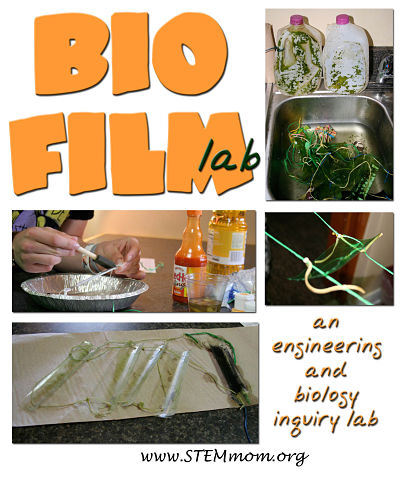BioFilm Experiment
While studying microbiology might not be on the top of your middle school or high school kid’s to-do list, you can entice them into the topic by talking about controlling the growth of microbes in swimming pools, or even closer to home, on the surface of their teeth! Colgate even has an article about biofilms!
Essentially biofilms are microscopic bacteria that adhere and grow on a surface. This You Tube video does a good job of explaining how biofilms form. I’ve designed this lab to have two parts. The first component is an engineering challenge where your students will design an apparatus to collect biofilm from a body of water. Then, they will coat plastic surfaces with different substances in an attempt to decrease the amount of biofilm growth. Two weeks later, they complete the biology portion of the lab when they collect their specimens and determine which coated surfaces controlled the bacterial growth best. Engineering & scientific process skills students will practice while conducting this lab.
- Designing an apparatus to collect bacteria
- Developing a research design to test an idea
- Predict outcome; make a hypothesis
- Collect data: categorizing results to make comparison easier
- Organizing data: constructing bar graphs
- Describing and drawing observations
- Verifying predictions
- Determining reasons for results
- Extrapolate results for what it may mean for society, and what additional experiments could follow
You will need to find a body of water in which to place the apparatus your kids will make. The apparatus need to remain submersed for two full weeks, so seek permission if you are going onto private property. If you don’t have pond water easily accessible, you can recreate your own pond. This is what we did. I placed two shovels full of dirt from a bare patch in the lawn into a large plastic garbage can and then filled it with water. You need to let this sit for at least a week before starting your experiment, so the organisms in the soil have time to take up housekeeping in their new home! 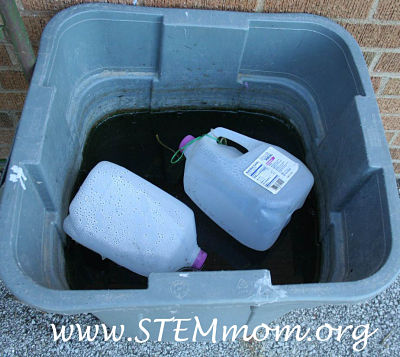
- Clean, empty soda bottles (one for each child or pair)
- Single hole punch
- Scissors
- Twine or rope
- rubber bands
- weights (rocks or pebbles)
- Large plastic jug
- Substances to coat the plastic such as; paint, oil, peppers, cayenne pepper, etc…
- foam brushes
- Other items requested by your kids!
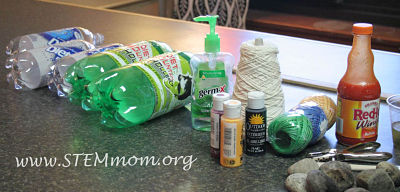
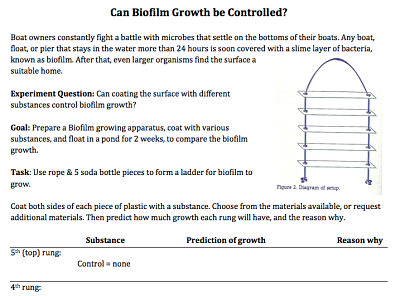
- How might the depth of the pond where we are placing the appartus change our design?
- What size do you think would be appropriate?
- How do you think the space between the steps of the ladder might influence how well the bacteria grows on the surface?
- How important is it to keep the steps of the ladder the same size?
- Will your rungs stay separated when they are placed in water? Maybe consider a trial to see how it behaves submersed.
- What’s the best way to keep the ladder stable, and less likely to be influenced by any water currents?
- How should you attach it to the large plastic jug?
- What sort of surface coatings might microbes be more likely stick? Less likely?

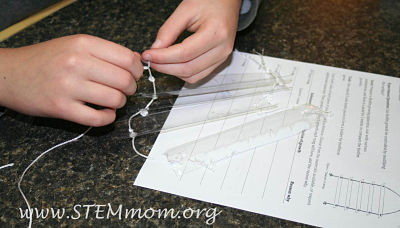
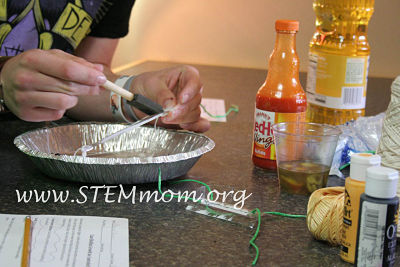
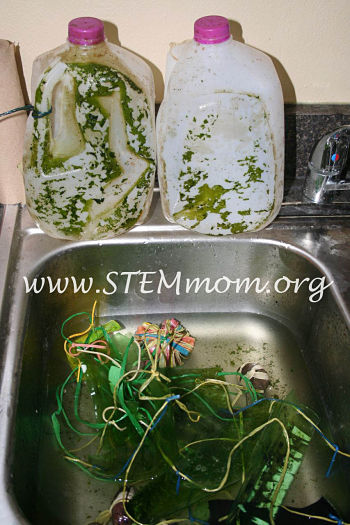
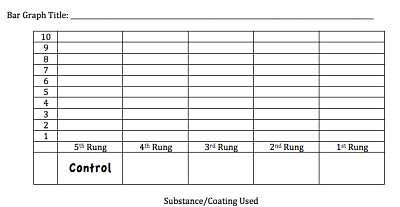
As with all my labs, I have post-lab questions that help students reinforce the scientific method process as they look back over their lab experience. There’s questions on extraneous variables (other outside influences that may have affected the results), a question on how confident they are that the results are reliable. I also want student to really think about why this matters. Can we control bacterial growth by changing or modifying a surface? Does painting help? What sort of industries might be affected by bacterial growth on water surfaces? Biofilm.org may help students make some of these applications.
Some student groups had more obvious differences in the amount of biofilm growth on their rungs. This is a great experiment to perform more than once. Allow students to tweak their ladders, application method etc… until they are confident that it is the substance they’ve added to the rung that inhibits bacteria growth, and not some extraneous variable.
I’d like to close with the warning to not let students complete this microbe lab with an “icky” attitude toward microbes. Bacteria get a bad wrap, but are absolutely essential to human existence. To hound this point home, one of my favorite TED talks is by Dr. Bonnie Bassler. She talks about the importance of bacteria, and gets a little into how they communicate with one another. The kids will like the first 2 minutes, you’ll enjoy all of it! My favorite quote from this TED talk is, “While you think of yourself as human beings, I think of you as 99 percent bacterial.”

through the MicrobeWorld Activities pg. 39-43.
*******************************
Darci is a traditionally trained science (and English) high school teacher, having spent 16 years in public education, but is now a new homeschooling mom. Darci’s passion is helping kids of all ages learn about the process of science, rather than the facts.She provides professional development for teachers wanting to implement student research,and is considering offering research experience for high schoolers in the online environment, who otherwise might not get the opportunity.
I hold a master’s degree in child development and early education and am working on a post-baccalaureate in biology. I spent 15 years working for a biotechnology company developing IT systems in DNA testing laboratories across the US. I taught K4 in a private school, homeschooled my children, and have taught on the mission field in southern Asia. For 4 years, I served on our state’s FIRST Lego League tournament Board and served as the Judging Director. I own thehomeschoolscientist and also write a regular science column for Homeschooling Today Magazine. You’ll also find my writings on the CTCMath blog. Through this site, I have authored over 50 math and science resources.



